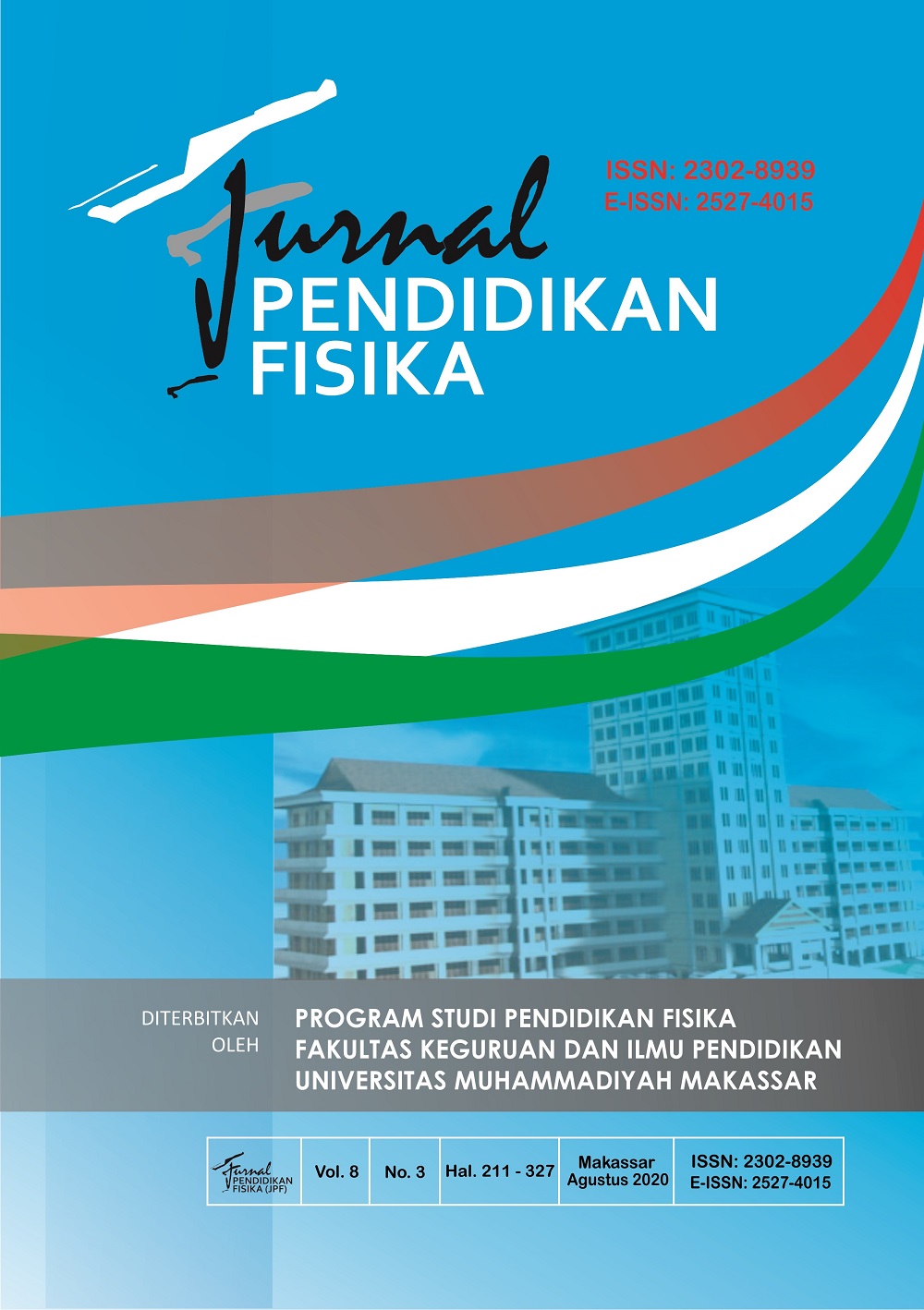Validity Analysis of the OrDeP2E Model of Physics Learning Tools to Improve Critical Thinking Skills of High School Students
DOI:
https://doi.org/10.26618/jpf.v8i3.3827Kata Kunci:
OrDeP2E Learning Model, Critical Thinking SkillsAbstrak
The purpose of this study was to determine the feasibility of the physics learning model of the OrDeP2E model to improve the critical thinking skills of high school students. The learning tool developed was assessed by two validation experts who were folus in the process of construct validity testing and the contents of the developed device. Validation data were obtained assesment sheet using categories 1-4. This study refers to the development of the 4-D model. Validated tools are 1) Syllabus, 2) lesson plan 3) student textbooks, 4) student worksheet, and 5) Critical thinking skills test. The results showed that 1) the syllabus got a score of 3.58 (valid), 2) the RPP got a score of 3.83 (very valid), 3) the BAS got a score of 3.54 (valid), 4) the worksheet received a score of 3.78 ( very valid), critical thinking skills test get a score of 3.70 (very valid). Based on the research results, learning tools are appropriate to be used to improve critical thinking skills of high school students.Referensi
Fadlillah. (2014). Implementasi Kurikulum 2013 Dalam Pembelajaran SD/MI, SMP/MTs, SMA/MA. Yogyakarta: Ar-ruzz Media.
Siburian, Corebima, Ibrohim dan Murni (2019).Analisis Validitas Hasil Pengembangan Perangkat Pembelajaran Ilmu Pengetahuan Lingkungan Berstrategi Inkuiri dan Instrumen Tes Kemampuan Berpikir Kritis, Berpikir Kreatif dan Hasil Belajar Kognitif Mahasiswa. Vol.5 No.1 June 2019 Hal 3147.:https://doi.org/10.22437/bio.v5i1.6825.
Panjaitan, M.,Nur & Jatmiko, B. (2016). Model Pembelajran Sains Berbasis Proses OrDeP2E untuk Meningkatkan Berpikir Kreatif dan Pemahaman Konsep Siswa SMP, Jurnal Pendidikan Indonesia, 11 (1), 8-22.DOI: 10.15294/jpfi.v1lil.3999
Doa, H, Astro, B,R, & Meke, P,D,K (2020). Validity Analysis of the Science Learning Tools using Appoaches to Improve Creative Thinking Skill of Junior High School Student. JPF, Vol 8 Nomor 2:176-189. Doi 10.26618/jpf.v8i2.3226.
Ibrahim, Gunawan dan Kosim. (2020). Validitas Perangkat Pembelajaran Fisika Berbasis Model Discovery Learning Dengan Pendekatan Konflik Kognitif. J. Pijar MIPA. Vol.15 No. 3:214-218. Doi: 10.29303/jpm.v15i3.1878.
Siburian, J, Coorebima,D,A, Ibrohim & Saptasari, M. (2019). Analisis validitas hasil Pengembangan Perangkat Pembelajaran Ilmu Pengetahuan Lingkungan Berstrategi Inkuiri dan Instrumen Tes Kemampuan Berpikir Kritis , Berpikir Kreatif dan Hasil Belajar Kognitif Mahasiswa. Biodik: Jurnal Ilmiah Pendidikan Biologi. Vol. 5 No. 1: hal 31- 45. Doi: https://doi.org/10.22437/bio.v5i1.6825.
Kemendikbud. (2016). Lampiran Permendikbud No. 22 Tentang Standar Proses Pendidikan Dasar dan Menengah. Jakarta: Kemendikbud.
Akbar, Sa’dun (2013). Instrumen Perangkat Pembelajaran. Bandung: Remaja Rosdakarya.
Kuswana S. Wowo. (2013) Taksonomi Berpikir. Bandung: Remaja Rosdakarya Offset.
Dwijananti dan Yuliyanti (2010). “Pengembangan Kemampuan Berpikir Kritis Mahasiswa Melalui Pembelajaran Problem Based Instruction Pada Mata Kuliah Fisika Lingkungan”. Jurnal Pendidikan Fisika Indonesia. 6 (2010): 108-114.
Facione, Peter. (2011). Critical Thinking. What It Is and Why Its Counts. Measured Reason and The California Academic Press.
Thiagarajan, S & D.S. Semmel. (1974). Instructional Development for Training Center of Exceptional Children. Minepolish: Indiana University.
Ratumanan, T. G. (2011). Penilaian Hasil Belajar pada Tingkat Satuan Pendidikan edisi 2. Surabaya: Unesa University Press.
Borich, Gary,D. (1974). Observation Skills for Effective Teaching. The University of Texas: USA.
Kardi, S. (2012). Pengantar Pengembangan Kurikulum dan Rencana Pelaksanaan Pembelajaran. Surabaya: Unesa University Press.
Rida, N, R, dkk (2019). Validitas LKS Berbasis Problem Solving Untuk Meningkatkan Keterampilan 4C pada Materi Suhu Kalor dan Teori Kinetik Kelas XI SMA/MA , Pillar of Physics Education, Vol 12 No 4, 753-760.
Utami,D,S, dkk. (2019). Validitas Perangkat Pembelajaran Etnoekologi Masyarakat Suku Sasak Kawasan Taman Nasional Gunung Rinjani. Jurnal Pendidikan IPA, 5(2), 240-247.
Ennis, R. H. (2011). Critical Thinking. The University of Illinois: Pretince Hall Inc.
Syarir, M. D, Putra, A & Dwiridal, L . (2018). Analisis Kelayakan Perangkat Pembelajaran Fisika Berorientasi Inkuiri Terbimbing Pada Materi Hukum Newton Tentang Gerak Untuk Pembelajaran Fisika Di Kelas X SMA/MA. Pillar of Physics Education, Vol 11 No 2, 33-40.
Unduhan
Diterbitkan
Terbitan
Bagian
Lisensi
Copyright:
Authors who publish with this journal agree to the following terms:
1. Authors retain copyright and grant the journal right of first publication with the work simultaneously licensed under a Creative Commons Attribution-ShareAlike 4.0 International License that allows others to share the work with an acknowledgement of the work's authorship and initial publication in this journal.
2. Authors are able to enter into separate, additional contractual arrangements for the non-exclusive distribution of the journal's published version of the work (e.g., post it to an institutional repository or publish it in a book), with an acknowledgement of its initial publication in this journal.
3. Authors are permitted and encouraged to post their work online (e.g., in institutional repositories or on their website) prior to and during the submission process, as it can lead to productive exchanges, as well as earlier and greater citation of published work.
Licence:
Authors are free to:
1. Share: Copy and redistribute the material in any medium or format
2. Adapt: Remix, transform, and build upon the material for any purpose, even commercially.
The licensor cannot revoke these freedoms as long as the authors follow the license terms, which include the following:
1. Attribution: You must give appropriate credit, provide a link to the license, and indicate if changes were made. You may do so in any reasonable manner, but not in any way that suggests the licensor endorses you or your use.
2. ShareAlike: If you remix, transform, or build upon the material, you must distribute your contributions under the same license as the original.
3. No additional restrictions: You may not apply legal terms or technological measures that legally restrict others from doing anything the license permits.
Jurnal Pendidikan Fisika is licensed under a Creative Commons Attribution-ShareAlike 4.0 International License.

